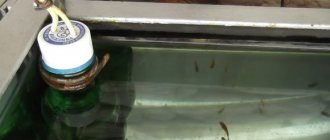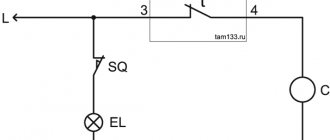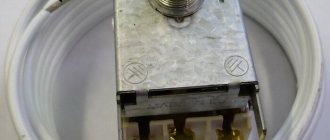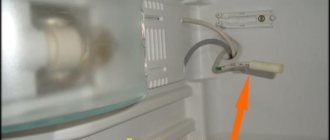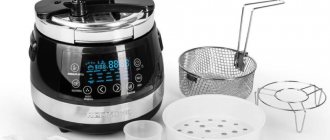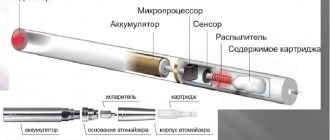Hello to all readers of my blog!
In this publication, I want to tell you how you can design a salt heater for an aquarium with your own hands using an ordinary plastic bottle. I can say with confidence that over the course of several years of operation of this heater, it has proven itself to be excellent.
Attention! If you do not know the safety precautions for handling electricity, do not undertake the manufacture of such an electrical appliance. To make a homemade salt heater you will need: a small plastic bottle, a piece of insulated electrical wire (preferably removed from the electrical appliance and with a plug installed), two rings 15 - 20 mm long, necessarily sawed off from a copper tube, and a piece of not very hard wire for making a hook for which hang the heater in the aquarium.
The first thing you need to do is make (you can burn a nail) three small holes in the cork of a plastic bottle. Two holes for the electrical wire, and the third for the exit of condensate, which will slowly evaporate from heating the water in the bottle. You can get by with two holes if they are made free enough.
After you make the holes in them, you need to insert the wires and then flatten the rings on the stripped ends of the wires. To do this, you need to take a hammer and push the wire into the ring and flatten it with a hammer blow; the same must be done with the second wire. Remember, in order to avoid a short circuit, the contacts placed in the bottle should always be apart, that is, one contact at the bottom at the very bottom of the bottle, and the second at the top, closer to the neck itself, but not higher than the level of water filled in the bottle.
Before filling the heater with water and installing it in the aquarium, you must first make a weighting material so that the bottle suspended in the aquarium does not tip over on its side. To do this, you need to pour some stones into the bottle; you can simply take some soil from the aquarium. The norm is checked experimentally: when in an aquarium, a bottle hung on the wall and filled with water stops turning over on its side, which means it is enough. A piece of not very rigid wire will be needed to make a hook for which the heater will be attached.
To do this, wrap the wire tightly around the neck of the bottle, leaving the end of the wire bent into a hook. After everything is done, you need to fill the bottle with water, but not to the edge of the neck to avoid accidental contact with water in the aquarium.
The correct placement of a water heater in an aquarium is to raise the neck of the bottle completely above the water level in the aquarium. It is important to know that the temperature of a salt heater is controlled by adding salt to it. The more salt you add, the higher the temperature of the heater will be and vice versa.
Based on this, you need to be very serious about adding salt, otherwise the water in the bottle will boil and you will kill your fish. I add salt after first dissolving it in a glass of water and only after that add drops to the water heater. Attention! When adding salt to the heater, as well as during all technical work involving moving and removing the plug from the heater, strictly only be carried out when it is disconnected from the network.
After adding salt to the water heater, the water temperature in the aquarium is monitored throughout the day. If after 24 hours it has reached the planned norm and does not rise higher, then the temperature limit is considered adjusted. And if the water temperature has risen above normal, then in this case you need to turn off the heater and replace some of the water in it with fresh water. For very small aquariums, the high water temperature is reduced by adding distilled water to the water heater. This kind of aquarium heater is not safe, but it can be very useful.
When setting up a home aquarium, you will need many components. After all, in order for the inhabitants of an artificial reservoir to feel good and comfortable, everything needs to be done wisely. One desirable tank component is a water heater. In this article we will talk about why it is needed, find out what these heaters , and figure out how to use such a device. In addition, a bonus for you will be detailed instructions on how to make a heater with your own hands, while saving money and learning something new.
Do you need a water heater?
Some novice aquarists believe that a water heater is not the most important thing. But they are very wrong. Many fish in their natural environment live in tropical and warm rivers.
Although summer is not yet an indicator, since the water temperature changes day and night and not every fish will survive these changes (even 2-4 degrees). Also, water can be affected by leaving a window open for a long time or suddenly turning off the heating in the apartment.
Types of water heaters
Water heaters come in different types. We will tell you about each of them below. You will choose the one that suits you best.
Submersible
How immersion heaters are used is already clear from their name. Such a water heater is lowered into the water to a certain mark on it. It looks like a cone or an oblong cylinder, inside of which there is a heating element. Its body must be heat-resistant and strong.
This device is made of different materials, it can be glass , plastic , titanium .
Flow-through
Such heaters are installed outside the tank, cutting into the filter hose. This ensures uniform heating of water. This device has a plastic body.
Its external placement, in addition, makes it possible to save on free space inside an artificial reservoir. True, it is recommended to use it in large aquariums, since there are no such water heaters with a power of less than 200 W.
Heating cables for aquariums (more common in terrarium farming)
Such heaters are installed under the ground, allowing the entire tank to be heated evenly. They also have a good effect on plant development.
This heater does not take up much space and is not visible under a layer of soil. True, if you want to remove it, you will have to disrupt the entire atmosphere of the artificial reservoir.
Cable heaters are more common in terrarium farming, but are also used for home aquariums.
Heating mats
These rectangular mats are placed under the bottom of the tank, through which the heat spreads evenly throughout the aquarium. It is believed that such heaters also have a beneficial effect on plants.
Naturally, you won’t be able to remove this water heater without lifting the glass house itself. But it will serve you much longer than other similar devices.
Which aquarium heater to choose
Growing fish in a glass container without a heater is doomed to failure. This method of keeping is suitable only for cold-blooded species of exotic creatures that do not need heating. Other individuals will quickly die in cold water. The list of important heating equipment includes:
- Heaters.
- Thermostat.
- Device for measuring temperature.
The listed devices are sold individually or as ready-made kits. The second option is more interesting, which is why many people purchase a complex heater for an aquarium with a thermostat. However, if 1 node is damaged, it will be impossible to restore it without large financial costs. If the devices are independent, you will have to combine them with each other, which requires some effort and time.
The power indicators of heating systems are selected taking into account the following proportions: 1 liter of water requires 1 W of power. However, there is no universal requirement for all systems, so at the selection stage you should consult with a specialist. You also need to read the manufacturer's instructions, which are indicated in the package insert or on the packaging. They are presented in the form of schematic drawings.
The heater is installed in such a way that the water is heated evenly at all levels. This will protect the aquarium flora and fauna from sudden changes and inevitable death.
Temperature is measured at the very bottom and in the surface layers. The permissible difference should not exceed 2ºС. To level it, just filter the water.
To heat the water in an aquarium, you can use the following types of heating systems:
- Glass device. Initially, the model may seem fragile and vulnerable to damage, but it is made of heat-resistant and impact-resistant material and is equipped with a sealed lid. There is a thermostat under the housing that provides temperature control.
- Plastic products. They are characterized by an advanced device and are made of impact-resistant plastic. The device is equipped with LED indicators, and its shape has a flattened appearance. Some models have temperature sensors.
- Devices with an external thermostat. They are famous for their compactness and the presence of a titanium heater. This solution is suitable for large aquariums.
- Compact submersible device. It is very popular and is intended for small containers. The disadvantage of the system is the lack of a built-in thermostat, so the owner of the aquarium must independently measure and regulate temperature indicators.
Flow heater
The flow-through aquarium heater is installed vertically on the return hose of the external filter. Among the key advantages of this type are:
- Ensuring a stable flow of heated water.
- Attractive appearance.
The disadvantage is the limited scope of application - flow-through systems are intended for large aquariums, as well as the lack of devices with low power.
Immersion heater
Submersible systems are lowered into water to a selected level and are an oblong cone or cylinder with a heating element. The devices are made from impact-resistant materials and are closed with a sealed lid. In most cases, they are made of glass, plastic and titanium.
External heater
In the classic version, such a system is connected to an external remote filter, i.e. During the cleaning process, the water will heat up additionally. There are other options where the heater is made in the form of a heating pad made of rubberized material with heating parts inside. The water is heated in a glass bottom.
The downside of the device is the loss of thermal energy, and heating the bottom increases the likelihood of bacterial growth.
Bottom heater for aquarium
Bottom-type systems involve laying special cables at the bottom of the aquarium and then filling them with soil. Among the basic operating characteristics of such systems are the following:
- Bottom heaters are designed to provide a stable flow of water in the soil, which eliminates the problem of soil acidification.
- The device effectively heats the lower layers of water, which cannot be achieved with other solutions.
- The bottom version can be used as a complement to other existing systems.
Experts do not recommend laying cables in soft sand.
How to choose the right one
No one can help you decide on a specific type of heater - choose what suits your aquarium best. When purchasing, be sure to consider two points - its power and thermostat.
The thermostat itself monitors the water temperature and, when necessary, turns on or off.
And the required power should be determined based on the following formula: 1 W per 1 liter of water. You should not use a stronger heater! If the device shorts out, the fish may die.
Why do you need a homemade thermostat?
Store-bought thermostats are very massive. They are designed for keeping large aquariums with whimsical animals. They are not suitable for beginner aquarists who breed small fish in small containers. And the costs will be unjustified (purchased water heating equipment is expensive). Therefore, a do-it-yourself thermostat for an aquarium is:
- Cheap (assembled from available materials);
- Practical (suitable for small aquariums and spawning grounds);
- Effective (a homemade device works no worse than an industrially created one).
The only thing you have to spend is time.
When is it necessary to buy a heater?
There is a significant difference between industrial and homemade devices: the purchased one heats the water itself, while the one made by hand heats the bottom. If in small aquariums, using convection, heat quickly spreads throughout the entire volume, then for large containers this is not enough.
To ensure that the water is the same temperature at all levels, you will have to use a commercial aquarium heater with a thermostat. But if you made a mistake in calculating the power, and it turned out to be insufficient, then building an assistant - a homemade thermostat - will help correct the mistake.
How to install
The device is mounted in the tank both vertically (the adjustment handle should be above the surface of the water) and horizontally, lowering the whole thing. Do not place it in the ground unless you are talking about cables.
The water level must exceed the minimum immersion level, that is, the “MINIMUM WATER LEVEL” icon, which you will see on the body of the device. Please note that due to evaporation this level drops from time to time.
The heater is installed on the wall of the “fish house” thanks to a bracket with two suction cups; it is mounted on the heater immediately under the head. Fix the device where water is always present and its movement is uniform.
How to make it yourself
You can also make a water heater yourself, following our step-by-step instructions. But remember to be extremely careful, because you risk getting an electric shock!
To create the device you will need resistors, a piece of glass tube with thick walls, dry filler, and a remote thermostat.
First you need to determine the power of the heating element based on this table:
Difference between water temperatures in the aquarium and in the room (°C)
- Calculate the current by dividing the power by the applied voltage. This way you will understand the resistance value of the heater. Select the required number of identical resistors (their total power and resistance indicators must correspond to the calculated values).
- Determine the length and diameter of the glass tube based on the size and number of resistances. Please note that resistors soldered in series must be placed in a tube with a free space of 15 cm.
- You can use purified and calcined sand as a filler.
- Close the bottom hole of the tube with a rubber stopper placed on the aquarium sealant.
- Solder the ends of the network cable to the upper and lower resistors. Place all this in a tube and cover it with sand (it should be at the bottom of the tube, covering the top resistor).
- Seal the top of the tube with aquarium sealant. Connect the power cable to a thermostat with a remote temperature sensor, which is lowered into the tank.
How to heat water in an aquarium :: DIY aquarium heater :: Aquarium fish
How to heat water in an aquarium
Most aquarium fish are tropical inhabitants. Water at room temperature is not suitable for them. The aquarium must be heated. This can be done in several ways.
Question: “Opened a pet store. Business is not going well. What to do? » — 2 answers
You will need
- - aquarium;
- - water thermometer;
- - thermostat;
- - incandescent lamps;
- - reflector;
- - aquarium heater.
Instructions
1. The oldest means of heating water is a reflector. You can make it yourself in the form of a tin half-cylinder. Attach the socket with an incandescent electric lamp to the end. The lamp must be inside the reflector. Hang the device from the end of the aquarium so that the top edge of the reflector is below the water level. This is necessary so that the glass heats up evenly and does not burst. This method is suitable for both heating and lighting small rectangular aquariums with a capacity of no more than 30 liters.
2. Immerse the incandescent lamp directly into water . At the same time, secure the cartridge on the lid in a special hole so that only the cylinder is in the water. Water must not touch the cartridge. The efficiency of such a system is significantly higher than that of a reflector. The power of this heating device is equal to the power of the lamp. But with this method, the flask becomes overgrown with algae.
3. The most advanced method is heating using a special heater. You can buy it at a pet store. This heater is a long test tube in which an electric coil is placed. The test tube is filled with fine dry quartz sand. The hermetically sealed terminals of the spiral are located in its upper part. Such a heater is connected to the network using a cord.
4. Heaters can be different in height and power. Choose one so that when immersed in the aquarium, the upper part with the wire leads is at least 2 cm above the water level. At the same time, the lower end should not rest against the bottom. To maintain the required temperature, you can adhere to the ratio of 10 l - 10 W.
5. Secure the heater in the aquarium
using rubber suction cups and plastic rings. If you cannot find them, you can use metal wire as a fastener. This mount must be above the water level.
6. Use a thermostat at the same time as the heater. They are also sold in pet stores. Monitor the temperature of the water in the aquarium using a thermometer immersed in it.
7. To heat the aquarium evenly, ensure water circulation - install some kind of filter. You can arrange aeration using a compressor.
note
The main disadvantage of heating using a reflector is that the device has to be turned off at night, and the water temperature drops to room temperature. The second disadvantage can be considered the increased overgrowth of lower algae on the glass located on the side of the reflector. In addition, this device has a rather low efficiency. There are salt heaters. As a rule, they are homemade. You shouldn't use them. Salt in the water can be harmful to some fish and plants.
KakProsto.ru>
Thermostat in the heater: is it necessary?
We have already mentioned that the thermostat in the heater is a necessary and important thing, because it independently monitors the water, heating it if necessary, which prevents temperature surges. You certainly won’t be able to constantly be near the aquarium and control everything. But the thermostat can.
According to manufacturing technology, such a device is of two types:
- Electronic . Highly accurate. Most representatives are equipped with information displays. True, such a thermostat is not cheap. It is also considered not reliable enough.
- Mechanical . The most common thermostat. It costs less, it is called stable and reliable. Although sometimes it distorts the correct readings, but only by a couple of degrees (use a separate thermometer for precise adjustments).
In addition, thermostats differ in their level of safety and duration of use. There are remote regulators that are mounted outside the tank, and built-in ones that are mounted in the housing along with the heating element.
The second option is very common among aquarists, since such a heating system is convenient to use. As they say, two in one.
Do you need a heater in an aquarium?
Most aquarium fish are representatives of tropical ichthyofauna, so a stable temperature is necessary for their normal existence. It varies between +26…+27˚С. This means that the owner of such creatures will need to buy a special thermostat for the aquarium. Its task and role are as follows:
- Many types of fish need thoroughly heated water, the temperature of which is above room temperature. Without additional heating, it is impossible to obtain it.
- At night, the water cools down greatly, and any surge has a negative impact on the condition of the pets.
- During winter, the water level may drop.
The listed factors explain why an aquarium heater is needed in an artificial pond. It is better to assess the water temperature in the morning when the lights are turned on. This is due to the fact that during the day the aquarium is additionally heated by lamps.
If you have a thermostat, you won't have to worry about possible temperature fluctuations. It is enough to periodically take measurements and adjust the mode.
If there is no heater, temperature readings will depend on the following factors:
- Thermal energy from lighting devices and the distance between them and the aquarium.
- Type of construction, shape and volume of the container.
- Compatible with running water supply system.
- Number of water change cycles.
Operating rules
When using a water heater for an artificial reservoir, you should remember the basic rules for its use:
- The heater can only be turned on in an electrical network with parameters that correspond to those indicated on the device.
- Do not turn on the heater when it is removed from the water.
- Before using the heater, be sure to turn off the voltage. And before you plunge your hand into the aquarium, make sure that the heater and other electrical appliances in the artificial pond are turned off.
- Do not use a heater that is damaged or has a damaged cord.
- It is not permitted to replace or repair the wire. If it breaks, buy a completely new device. In addition, it is not allowed to mount a switch on a wire.
- As already stated, the water level must exceed the minimum immersion level. The maximum level is 80 cm.
- The heater can only be used in aquariums and certainly in enclosed spaces.
What to look for when purchasing
In a separate paragraph, we will return to what needs to be taken into account when purchasing a water heater.
As you know, this is the presence of a thermostat. We hope that now you understand that, in fact, there is no way to do without it. The main thing is not to forget to monitor its serviceability.
And, of course, this is power. A lot depends on it. After all, incorrectly selected power can cause a lot of trouble. Once again we remind you of the calculation formula: 1 W per 1 liter of water.
After reading this article, you are unlikely to doubt the need for such a device as a water heater. Although there are also aquarists who, for some reason, refuse it. Naturally, the choice is always yours, but it’s probably still not worth risking the lives of the inhabitants of the glass house if they are really dear to you. After all, everyone wants an aquarium to bring joy, and not cause constant trouble.
Currently, there are a large number of people who like to keep exotic fish at home. And their maintenance and breeding cannot be done without special equipment. If you are going to have fish in an aquarium, you will definitely need a water heater. With its help, it is possible to maintain the optimal temperature in an artificial reservoir for the full development and functioning of residents .
There is a wide variety of aquarium heaters:
- Submersible. They are made from a variety of materials (plastic, titanium, glass). They have the shape of a flask with a heating element inserted inside it. This heater is partially or completely lowered into the aquatic environment.
- Instantaneous water heaters. The thermostat of this type of device is located outside the aquarium. This saves interior space.
- Heating cables. Perfect for heating round aquariums. The cable is placed underground. This ensures even heating of the water.
- Mats for heating water. They should be installed under the aquarium. The water is heated through the bottom of the container.
Aquarium thermostats
These are devices with a built-in thermostat. You set the required water temperature, and the device heats it up to the required numbers. After this, it automatically turns off, turning on after the medium begins to cool.
There are 2 types of such water heating devices.
Important! Mechanical devices are less accurate (the error is from 1 to 2 degrees), but have a lower cost. Electronic devices are much more accurate, but their cost is much higher.
Most devices come without a built-in thermometer. The device maintains the optimal temperature, but does not display its value. Therefore, you need to purchase a special thermometer for water along with the thermostat.
When choosing an aquarium water heater, you need to pay attention to the following characteristics:
- Correct selection of power.
- The presence of thermoregulation.
Important! It is believed that a 10 W device is enough to heat 4.5 liters of water. For an artificial reservoir of larger volume, it is better to buy not one powerful device, but several low-power ones: this way it is easier to heat the water to optimal levels.
Advantages
Modern models of water heating devices have the following advantages:
- Reliability.
- Possibility of placement under water.
- Safety.
Important! During prolonged use, the device may produce errors, so it must be checked periodically using a regular thermometer.
Now about which water heater for an aquarium is better. If you are using shallow soil, it is advisable to use a thermal cable heater. In this case, you not only maintain the necessary environmental characteristics, but also create better conditions for aquatic plants. In addition, heated water freely rises to the surface without stagnating in the ground.
Aquarium heater with thermostat
If the aquarium contains tropical fish, the water temperature should be an order of magnitude higher than the air temperature in the room. To maintain uniform water temperature during the day and night, aquarium heaters with a special thermostat are installed. The latter is equipped with a sensor. It heats the water to the set temperature, after which it turns off the heating element. When the water temperature begins to drop, the thermostat turns the device back on.
The thermostat allows you to maintain a certain microclimate, and aquarists do not have to worry that their pets will die due to hypothermia or overheating of the water.
There are two types of thermostats:
How to properly install a heater (heater) in an aquarium
A city apartment in Russia is not at all a place where tropical fish can be content with water at room temperature when cold weather arrives. The brightest southern species need warm (about 25°C and above) water all year round - failure to comply with this condition leads not only to refusal of spawning, but also to pale color, decreased immunity and activity, deterioration of appetite and gradual exhaustion. To prevent winter from becoming fatal for colorful pets, you should take care of purchasing a heater for the aquarium in advance.
Installation
To maintain the desired microclimate in the aquatic environment, you need to know how to install a heater in an aquarium. The water heater can be installed in both horizontal and vertical positions. When installed vertically, the adjustment handle should be located above the water level. When positioned horizontally, the heater is completely immersed in the aquatic environment.
The body of the heater is usually marked with water immersion level marks. The appliance must be installed so that the water is above the minimum immersion level. Over time, water evaporates, so you need to ensure that it does not fall below the minimum level.
The heater must not be installed in gravel or sand.
A bracket is installed under the heater head, which is attached to the wall of the aquarium using suction cups.
Please note that the installed device can only be turned on after 15-20 minutes. During this time, the temperature of the heater will become equal to the temperature of the water in the artificial reservoir. Only after this the device is connected to the network.
Thermostat for an aquarium and everything you need to know about it.
Keeping fish requires certain temperature conditions. Many fish are tropical, so the water temperature acceptable for their life can be no lower than 23-27 degrees. In winter, without heating the water, the fish may simply die. Therefore, water heaters are important equipment.
An aquarium water thermostat is a water heater with a built-in regulator. It consists of a glass tube with a heating element. Thermostats automatically turn off when the set heat level is reached and turn on when the temperature drops below the required level. They operate in the range of 18-32 degrees Celsius.
Installing a thermostat for an aquarium
First you need to choose the power of the device, which is necessary for the aquarium and depends on the volume of water in it. It is generally believed that 10 watts of power is sufficient to heat 4.5 liters of water. For a large aquarium, instead of one powerful device, it is better to buy several weak ones - this way the water will heat up more evenly.
There are submersible or ground water heaters. It is necessary to install and operate the aquarium thermostat strictly according to the instructions in order to prevent damage to the device or its failure.
The submersible aquarium thermostat is waterproof and can be installed both vertically and horizontally. The water level in the container must always be above the minimum immersion line, which is marked on the body. The heater is attached to the wall of the aquarium using brackets with suction cups. It must be installed in a place in the aquarium where there is constant circulation of water. The submersible thermostat cannot be installed in the ground. The maximum depth of location usually varies within 1 meter. You can connect the thermostat to the electrical network 15 minutes after its installation.
There is another type of thermostat - a ground heater (thermal cable). It is placed at the bottom of the aquarium and masked with plants and decorations. The thermal cable will ensure uniform heating of the water, because warm water circulates and rises to the surface.
It is forbidden to turn on the heater when removed from the aquarium, or to put your hand in the water while the device is on.
Heaters are essential equipment for an aquarium during the cold season. By maintaining the temperature level in the aquarium, optimal comfortable conditions will be created for its inhabitants.
What power thermostat to choose.
In general, you can calculate the thermostat here: calculating the power of the thermostat
But, there is one BUT. Chinese products, non-Chinese products, and even branded products are prone to sticking. Sticking thermostat A situation where, regardless of the temperature setting, the thermostat works to heat all the time, i.e. becomes a heating pad of a certain power.
What happens as a result of sticking. If we don’t look at the thermometer every day or put our hands in the water, if at the same time it’s warm in the apartment, if the wattage was selected using a calculator based on the lower threshold of the temperature in the room, and now it’s warm in our house, in the totality of this situation we can easily get fish soup.
In addition, it was previously accepted, and even now this trend is roaming the network, to assume a power of 1 watt per 1 liter. This is as wrong as 1 cm of fish per 1 liter. But unfortunately, even famous brands do not hesitate to write wild ranges of use on their boxes. And we, having a standard 23 degrees in the apartment and wanting to raise it to 25, buy a 150-liter thermostat, a 150-watt thermostat. This is a great evil. Because If such a heating pad sticks, we can get fish soup. Of course, a lot depends on the current, surface ventilation, etc., but the fish will easily lie at 35 degrees. And this is quite possible to achieve.
How to be. Let me explain with a simple example. We have 150 liters, we need to get 30 degrees in it (for example). The standard temperature in our room, for example, is 25, but during periods when housing residents are blown away, it drops to 21, and in the summer it rises to 28-30. We enter the boundary zones in the calculator, 21 as the minimum temperature in the room and 30 as the desired maximum in the aquarium. Using the calculator we get a value of 116 W. What should I do? The correct solution in this case is to install 2 heating pads of 50 W each. If one sticks, nothing will happen to your fish, and the likelihood of two sticking at the same time is reduced to zero.
What I would like to note. If you are at home all the time, constantly look at the thermometer and easily notice non-standard behavior of fish, then perhaps you do not need these instructions, but, as they say, it’s better to be safe. Well, if you don’t care about fish, you can also ignore everything written)
Another important digression is mini aquariums. A scheme with 2 heating pads will not work in them. Why? Because the minimum power of heating pads for 99% of manufacturers is 25 watts. Putting 25 watts, for example, in 10 liters is, IMHO, harsh. How can we be here? The simplest option is not to install a heating pad if temperature conditions and hydrobionts allow it.
Most aquatic organisms live in a wide range of temperatures and their slow movement within the limits is not a problem. The second option, which will cost you much more than your aquarium, is connecting the heating pad through an additional temperature relay. Essentially, you get a circuit protected by 2 relays, one built into the thermostat and an external one. In this case, the probability of fish soup is again 0.
Of course, many will say, “What for do I need all this reinsurance?” Of course, this is some kind of reinsurance, but if you have expensive hydrobionts in your aquarium or they are simply dear to you, then taking into account the fact that the quality of aquarium products is steadily declining in order to reduce production costs, this scheme still makes sense.
- Twin heaters with thermostat . As a rule, the design of such a device is quite simple: a heater in the form of a spiral is enclosed in one glass flask with a bimetallic thermostat. These two devices are already connected to the same circuit, so the aquarist does not need to connect anything, just insert the plug into the socket. This device must be secured in a strictly vertical position, otherwise the thermostat will turn off prematurely.
Why do you need a homemade thermostat?
Store-bought thermostats are very massive. They are designed for keeping large aquariums with whimsical animals. They are not suitable for beginner aquarists who breed small fish in small containers. And the costs will be unjustified (purchased water heating equipment is expensive). Therefore, a do-it-yourself thermostat for an aquarium is:
- Cheap (assembled from available materials);
- Practical (suitable for small aquariums and spawning grounds);
- Effective (a homemade device works no worse than an industrially created one).
The only thing you have to spend is time.
When is it necessary to buy a heater?
There is a significant difference between industrial and homemade devices: the purchased one heats the water itself, while the one made by hand heats the bottom. If in small aquariums, using convection, heat quickly spreads throughout the entire volume, then for large containers this is not enough.
To ensure that the water is the same temperature at all levels, you will have to use a commercial aquarium heater with a thermostat. But if you made a mistake in calculating the power, and it turned out to be insufficient, then building an assistant - a homemade thermostat - will help correct the mistake.
The simplest DIY heater
The device is actually simple: it does not have a thermostat. But due to the low power, you will not be able to overheat the water in the aquarium: no one will cook in it. However, exceeding the norm by 1-2 degrees is quite likely. To prevent this, place a water thermometer in the aquarium. And when the water heats up to the desired level, turn off the heater (if you forget to turn it off, nothing bad will happen if you chose the right wire resistance).
To build it you will need:
- Silicone tube or dropper;
- Transformer winding or wires of various diameters (will need to be selected);
- Power supply in the range of 12-24 V;
- Two plastic tube plugs;
- Silicone;
- Glycerin is liquid, or at worst, just water;
- Soldering iron, wire cutters.
First you need to calculate the power of the heater based on the standard: 0.5-1 W per liter of water. The warmer the water is needed, the more powerful the heater should be. The calculation is made using the formula:
W=w*V,
Where W is the desired heater power, w is the selected power for 1 liter of water, and V is the volume of the aquarium.
Example : the volume of your aquarium is 20 liters, and you want to heat it medium. Then take the average power (0.75 W/l). We get: 0.75*20=15 W.
Now you need to calculate the length of the wire from the transformer winding. To do this, calculate the required resistance using the formula:
R=U*U/W,
Where R is the desired resistance, U is the voltage of the current source (which one do you have, 12 or 24 Volts?). And W is the required power, which you have already found.
Example : you need a 15 W heater with a 12 V source. Then the resistance is 12 * 12/15 = 9.6 Ohms.
Now you need a formula to calculate the length of the wire:
L=S*R/p,
Where L is the required length, S is the cross-section of the wire, and p is the resistivity of the material from which it is made.
Attention! Transformer winding has a thickness of 0.3 mm. Therefore, the cross section will be equal to the area of a circle of the same diameter - 0.07 square meters. mm. The winding is made of copper, the resistivity of which is known to be 0.018 Ohm*sq. Mmm.
Example : You need a resistance of 9.6 ohms. Substituting known values into the formula, we get: 0.07*9.6/0.018=37.3 m.
Then make your own thermostat for the aquarium according to the instructions:
- Insert the wire inside the tube;
- Solder the ends to the wire going to the current source;
- Place the soldering area in a plastic plug;
- Fill the cavity of the plug with silicone so that the tube becomes airtight at one end;
- Pour liquid glycerin through the other end of the tube. If it is not there, then water will do, but it conducts heat worse;
- To seal the remaining end of the tube, use a second plug and some silicone.
Now the heater can be used for its intended purpose: lower it to the bottom and connect to the power source. But if you want to be able to regulate the temperature, you will have to invest more effort and money to make an aquarium water heater with a thermostat.
DIY automatic heater
This method allows you to create an aquarium heater that independently regulates the temperature set by the user. But you can make a device only if you have special knowledge in the field of radio engineering.
To make an aquarium heater with a thermostat, you will need:
- Transformer 12-volt;
- IN4007 (diodes) – 6;
- Electrolytic capacitors at 47, 100 and 2000 μF;
- 5V stabilizer chip (fits 7805);
- KT 814A (transistor);
- Adjustable zener diode (KR142EN19A or TL431);
- Fixed resistors for 150, 910, 4,700 and 160,000 Ohms;
- 150,000 ohm variable resistor;
- Instead of a sensor, you will need a 50,000 Ohm thermal resistor (TCS “-”);
- Low power consumption diode;
- Electromagnetic relay (12 V and < 0.1 A);
- Toggle switch (button).
A failed meter (Granit-1 in the photo) is suitable for the case. And the payment will come in handy from him. Both the power supply and the electromagnetic relay are placed inside.
The photo shows a suitable automotive relay, where the coil operates at 0.1 A.
It is impossible to include an auto relay in the circuit, since the maximum current of the adjustable zener diode cannot be more than 100 mA. In this regard, the purchase of a powerful resistor KT814 is required. If you want to make the circuit simplified, then instead of a car relay, take another one so that the current is less than 0.1 A (for example, SRA-12VDC-AL, and another one - SRD-12VDC-SL-C). Such models can be connected to a zener diode circuit without a resistor.
The photo shows an unusual transformer. This is a coil borrowed from an outdated induction electric meter.
It can be seen that there is some free space that can be used to wind the winding. But since the cross-section of the core is small, it will not be possible to achieve high power. However, for an aquarium regulator, adding 540 turns will be sufficient, based on the fact that 1 Volt is 45 turns. There will be no problems with their capacity if you choose the right diameter - 0.4 mm. But in order not to waste time, you can purchase an adapter or a new unit, initially designed for 12 Volts.
It can be seen that the circuit provides a 7805 stabilizer with a constant output voltage of 5 V. It is from this that the zener diode is powered. Therefore, the thermostat will have stable characteristics that will remain constant even when the supply voltage surges.
The temperature sensor in this case is a thermal resistor, the resistance of which is 50,000 Ohms at room temperature. However, its resistance will drop when heated.
It must be protected from mechanical damage using heat-shrinkable tubes.
On the right side of the temperature controller is a good place for resistor R1. If its axis is short, you will have to solder a flag (you can turn it over). And on the left is a toggle switch that regulates the operation of the device at a constant temperature set by the user.
It can be seen that the terminal block is too large, but there is no need to remove it, because any plug fits perfectly into it. To measure the current that will be supplied to the load, you need to remove the yellow jumper on the right and instead connect an ammeter in series.
Now it’s time to make a thermostat scale using the TM-902C electronic thermometer. Device sensors must be combined with electrical tape.
Use a thermometer to measure the temperature of bodies of varying degrees of heat. The scale can be made in different ranges. In the figure it was 8-60 degrees Celsius. If the temperature needs to be adjusted, this can be done using resistors R1-3.
Now the homemade heater with a thermostat for the aquarium is ready. It looks something like this.
Since the transparent glass of the meter exposes all the insides of the thermostat, it does not look aesthetically pleasing. You can fix this by covering everything unsightly with tape. However, if you are a creative person, then you can work on the body more.
Such a heater with a temperature controller will turn on at a temperature below the user set one. If necessary, it can be done so that the load is supplied at a temperature if it is higher than the set one. To do this, you need to swap the resistor that plays the role of sensor (R2) with resistors numbered 1 and 3.

